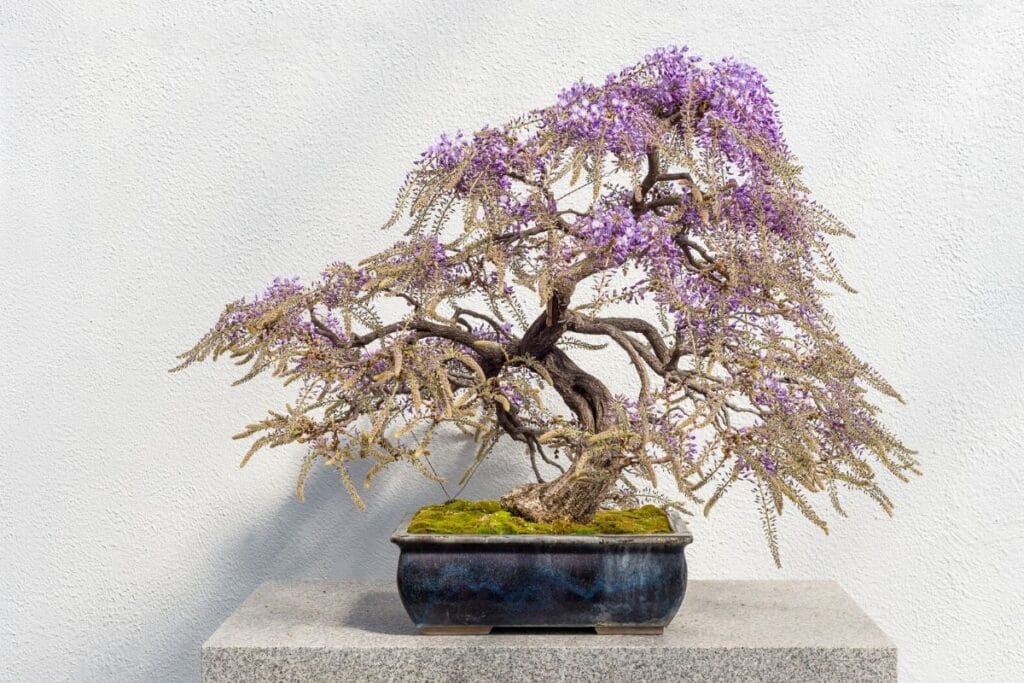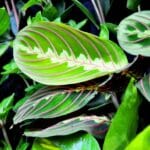Wisteria is often grown because it is fast growing deciduous vine that can trail elegantly over facades and pergolas. In fact, if you live in the south or another moderate climate, you may have considered growing this plant in your own backyard (or perhaps you already do!).
But did you know that Wisteria can also be grown as a bonsai plant? Wisteria is particularly well-suited to being grown as a bonsai plant because it has such gorgeous, elegant flowers.
While you’ll need to take some special care to make sure your wisteria bonsai remains healthy, this is luckily pretty easy to do – with some guidance, of course, that we can provide in this article.
Interesting Facts about Wisteria Bonsai
When it comes to wisteria symbolism, the plant is known for representing love, creativity, fertility beauty, and long life.
Here are some basic facts about this bonsai plant:
| Height | 21-25” |
| Width | 1-3” |
| Sunlight | Full sunlight |
| Flowering Time Length | Spring |
| Lifespan | 250 years |
| Scientific name | Wisteria sinensis and Wisteria floribunda |
Types of Wisteria Bonsai
There are two types of wisteria that are commonly used for bonsai – Chinese Wisteria, or Wisteria sinensis, and Japanese Wisteria, or Wisteria floribunda.
While Japanese Wisteria produces large, long flower clusters, Chinese Wisteria offers beauty in its own right, too.
You will find other cultivars, too (there are more than ten species in the wisteria genus) with colors ranging from pink to white and even dark purple.
Growing Wisteria Bonsai from Seed or By Propagation
Wisteria can be grown from cuttings or from seed. It is easiest to grow from seed, but it’s important to note that seedings do not flower before they are ten to fifteen years old.
If you choose to cultivate wisteria bonsai from cuttings, grated plants, or air layers, you will enjoy blossoms much sooner.
How To Care for Wisteria Bonsai
Sunlight
Place your wisteria bonsai in full sunlight during the peak of the growing season. This plant needs a lot of light in order to flower.
It is a frost-hardy plant when grown in the ground, but unfortunately, wisteria has relatively fragile roots when it is grown in a container.
Therefore, you may want to bring your wisteria plant indoors into a cool location, like a garage, that is sheltered from the frost during the winter months.
Watering
You will need to provide your wisteria plant with lots of water, especially during the growing season. In the summer, set the bonsai pot in a shallow bowl that is filled with water every time the tree is watered.
Fill this up with water when you water your plant. This will help keep the roots moist, which is vital during the drying fall and winter months.
Fertilizing
You can fertilize your wisteria bonsai once per month with an organic fertilizer that is a solid form. You can also use a liquid fertilizer once per week during the growing season.
This plant grows quickly and likes being fed often, but you will need to use a fertilizer that is high in nitrogen to get the job done.
Potting and Repotting
You can report your wisteria bonsai once every two years while the plant is young. When it’s older, just once every three to five years is fine.
When you pot, prune the roots, but be careful about being too zealous with your pruning when you are caring for older plants. Repot into a container with a standard soil mix with a mostly neutral pH.
Pruning a Wisteria Bonsai
It’s best to prune a wisteria bonsai in the early spring or after flowering. You will want to wait until the tendrils have grown a bit before cutting them back.
You can prune the woody structures, like branches and twigs, after the leaves have fallen. You should avoid allowing multiple seed pods to develop on the plant, as this can cause it to expend energy unnecessarily.
Don’t trim the short shoots that hold the flower buds. Close inspection reveals that the flower buds are distinct from the leaf buds.
Pests and Diseases
Wisteria bonsai is not prone to very many issues, especially if it is grown in the right conditions. However, you may have issues with fungal problems like leaf spot and powdery mildew.
To prevent this, remove affected leaves early on. You might have to occasionally watch out for root rot, too, which can be prevented by proper watering techniques.
The most harmful insect is the Wisteria borer, which burrows into the transport tissues and can destroy the tree. Unfortunately, even with strong chemical insecticides, the borer is difficult to suppress.
Where to Buy Wisteria Bonsai
You can purchase wisteria plants just about anywhere, from local nurseries to online retailers. However, look for those that are cultivated specifically for bonsai and make sure you buy from a reputable retailer. This can prevent problems with disease later on.
For a complete guide how to care for bonsai, read this bonsai care article.
FAQs
What is the difference between Chinese and Japanese Wisteria bonsai?
The primary difference between Chinese and Japanese Wisteria bonsai lies in their characteristics and growth habits. Chinese Wisteria (Wisteria sinensis) typically has longer flower clusters and a more vigorous growth pattern, while Japanese Wisteria (Wisteria floribunda) tends to have shorter flower clusters and a more controlled growth habit, making it more suitable for bonsai cultivation.
Do wisteria bonsai lose their leaves?
Yes, wisteria bonsai are deciduous, meaning they shed their leaves in the fall. During the winter months, they enter a period of dormancy characterized by leaf loss, and new leaves emerge in spring as the growing season begins.
*Photo by marcbruxelle/depositphotos







